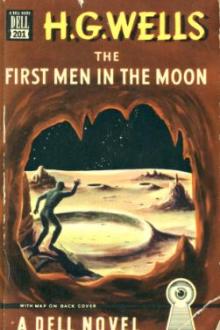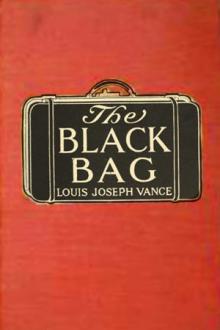The First Men in the Moon, H. G. Wells [romantic novels in english TXT] 📗

- Author: H. G. Wells
- Performer: -
Book online «The First Men in the Moon, H. G. Wells [romantic novels in english TXT] 📗». Author H. G. Wells
He does not mention the ant, but throughout his allusions the ant is continually being brought before my mind, in its sleepless activity, in its intelligence and social organisation, in its structure, and more particularly in the fact that it displays, in addition to the two forms, the male and the female form, that almost all other animals possess, a number of other sexless creatures, workers, soldiers, and the like, differing from one another in structure, character, power, and use, and yet all members of the same species. For these Selenites, also, have a great variety of forms. Of course they are not only colossally greater in size than ants, but also, in Cavor’s opinion at least, in intelligence, morality, and social wisdom are they colossally greater than men. And instead of the four or five different forms of ant that are found, there are almost innumerably different forms of Selenite. I have endeavoured to indicate the very considerable difference observable in such Selenites of the outer crust as I happened to encounter; the differences in size and proportions were certainly as wide as the differences between the most widely separated races of men. But such differences as I saw fade absolutely to nothing in comparison with the huge distinctions of which Cavor tells. It would seem the exterior Selenites I saw were, indeed, mostly engaged in kindred occupations—mooncalf herds, butchers, fleshers, and the like. But within the moon, practically unsuspected by me, there are, it seems, a number of other sorts of Selenite, differing in size, differing in the relative size of part to part, differing in power and appearance, and yet not different species of creatures, but only different forms of one species, and retaining through all their variations a certain common likeness that marks their specific unity. The moon is, indeed, a sort of vast ant-hill, only, instead of there being only four or five sorts of ant, there are many hundred different sorts of Selenite, and almost every gradation between one sort and another.
It would seem the discovery came upon Cavor very speedily. I infer rather than learn from his narrative that he was captured by the mooncalf herds under the direction of those other Selenites who “have larger brain cases (heads?) and very much shorter legs.” Finding he would not walk even under the goad, they carried him into darkness, crossed a narrow, plank-like bridge that may have been the identical bridge I had refused, and put him down in something that must have seemed at first to be some sort of lift. This was the balloon—it had certainly been absolutely invisible to us in the darkness—and what had seemed to me a mere plank-walking into the void was really, no doubt, the passage of the gangway. In this he descended towards constantly more luminous caverns of the moon. At first they descended in silence—save for the twitterings of the Selenites—and then into a stir of windy movement. In a little while the profound blackness had made his eyes so sensitive that he began to see more and more of the things about him, and at last the vague took shape.
“They carried him into darkness”
“Conceive an enormous cylindrical space,” says Cavor in his seventh message, “a quarter of a mile across, perhaps; very dimly lit at first and then brighter, with big platforms twisting down its sides in a spiral that vanishes at last below in a blue profundity; and lit even more brightly—one could not tell how or why. Think of the well of the very largest spiral staircase or lift-shaft that you have ever looked down, and magnify that by a hundred. Imagine it at twilight seen through blue glass. Imagine yourself looking down that; only imagine also that you feel extraordinarily light, and have got rid of any giddy feeling you might have on earth, and you will have the first conditions of my impression. Round this enormous shaft imagine a broad gallery running in a much steeper spiral than would be credible on earth, and forming a steep road protected from the gulf only by a little parapet that vanishes at last in perspective a couple of miles below.
“Looking up, I saw the very fellow of the downward vision; it had, of course, the effect of looking into a very steep cone. A wind was blowing down the shaft, and far above I fancy I heard, growing fainter and fainter, the bellowing of the mooncalves that were being driven down again from their evening pasturage on the exterior. And up and down the spiral galleries were scattered numerous moon people, pallid, faintly self-luminous beings, regarding our appearance or busied on unknown errands.
“Either I fancied it or a flake of snow came drifting down on the icy breeze. And then, falling like a snowflake, a little figure, a little man-insect clinging to a parachute, drove down very swiftly towards the central places of the moon.
“The big-headed Selenite sitting beside me, seeing me move my head with the gesture of one who saw, pointed with his trunk-like ‘hand’ and indicated a sort of jetty coming into sight very far below: a little landing-stage, as it were, hanging into the void. As it swept up towards us our pace diminished very rapidly, and in a few moments, as it seemed, we were abreast of it and at rest. A mooring-rope was flung and grasped, and I found myself pulled down to a level with a great crowd of Selenites, who jostled to see me.
“It was an incredible crowd. Suddenly and violently there was forced upon my attention the vast amount of difference there is amongst these beings of the moon.
“Indeed, there seemed not two alike in all that jostling multitude. They differed in shape, they differed in size, they rang all the horrible changes on the theme of Selenite form! Some bulged and overhung, some ran about among the feet of their fellows. All of them had a grotesque and disquieting suggestion of an insect that has somehow contrived to mock humanity; but all seemed to present an incredible exaggeration of some particular feature: one had a vast right fore-limb, an enormous antennal arm, as it were; one seemed all leg, poised, as it were, on stilts; another protruded the edge of his face mask into a nose-like organ that made him startlingly human until one saw his expressionless gaping mouth. The strange and (except for the want of mandibles and palps) most insect-like head of the mooncalf-minders underwent, indeed, the most incredible transformations: here it was broad and low, here high and narrow; here its leathery brow was drawn out into horns and strange features; here it was whiskered and divided, and there with a grotesquely human profile. One distortion was particularly conspicuous. There were several brain cases distended like bladders to a huge size, with the face mask reduced to quite small proportions. There were several amazing forms, with heads reduced to microscopic proportions and blobby bodies; and fantastic, flimsy things that existed, it would seem, only as a basis for vast, trumpet-like protrusions of the lower part of the mask. And oddest of all, as it seemed to me for the moment, two or three of these weird inhabitants of a subterranean world, a world sheltered by innumerable miles of rock from sun or rain, carried umbrellas in their tentaculate hands!—real terrestrial-looking umbrellas! And then I thought of the parachutist I had watched descend.
“These moon people behaved exactly as a human crowd might have done in similar circumstances: they jostled and thrust one another, they shoved one another aside, they even clambered upon one another to get a glimpse of me. Every moment they increased in numbers, and pressed more urgently upon the discs of my ushers”—Cavor does not explain what he means by this—“every moment fresh shapes emerged from the shadows and forced themselves upon my astounded attention. And presently I was signed and helped into a sort of litter, and lifted up on the shoulders of strong-armed bearers, and so borne through the twilight over this seething multitude towards the apartments that were provided for me in the moon. All about me were eyes, faces, masks, a leathery noise like the rustling of beetle wings, and a great bleating and cricket-like twittering of Selenite voices....”
We gather he was taken to a “hexagonal apartment,” and there for a space he was confined. Afterwards he was given a much more considerable liberty; indeed, almost as much freedom as one has in a civilised town on earth. And it would appear that the mysterious being who is the ruler and master of the moon appointed two Selenites “with large heads” to guard and study him, and to establish whatever mental communications were possible with him. And, amazing and incredible as it may seem, these two creatures, these fantastic men-insects, these beings of another world, were presently communicating with Cavor by means of terrestrial speech.
Cavor speaks of them as Phi-oo and Tsi-puff. Phi-oo, he says, was about 5 ft. high; he had small, slender legs about 18 in. long, and slight feet of the common lunar pattern. On these balanced a little body, throbbing with the pulsations of his heart. He had long, soft, many-jointed arms ending in a tentacled grip, and his neck was many-jointed in the usual way, but exceptionally short and thick. His head, says Cavor—apparently alluding to some previous description that has gone astray in space—“is of the common lunar type, but strangely modified. The mouth has the usual expressionless gape, but it is unusually small and pointing downward, and the mask is reduced to the size of a large flat nose-flap. On either side are the little eyes.
“The rest of the head is distended into a huge globe, and the chitinous leathery cuticle of the mooncalf herds thins out to a mere membrane, through which the pulsating brain movements are distinctly visible. He is a creature, indeed, with a tremendously hypertrophied brain, and with the rest of his organism both relatively and absolutely dwarfed.”
In another passage Cavor compares the back view of him to Atlas supporting the world. Tsi-puff, it seems, was a very similar insect, but his “face” was drawn out to a considerable length, and the brain hypertrophy being in different regions, his head was not round but pear-shaped, with the stalk downward. There were also litter-carriers, lop-sided beings with enormous shoulders, very spidery ushers, and a squat foot attendant in Cavor’s retinue.
The manner in which Phi-oo and Tsi-puff attacked the problem of speech was fairly obvious. They came into this “hexagonal cell” in which Cavor was confined, and began imitating every sound he made, beginning with a cough. He seems to have grasped their intention with great quickness, and to have begun repeating words to them and pointing to indicate the application. The procedure was probably always the same. Phi-oo would attend to Cavor for a space, then point also and say the word he had heard.
The first word he mastered was “man,” and the second “Mooney”—which Cavor on the spur of the moment seems to have used instead of “Selenite” for the moon race. As soon as Phi-oo was assured of the meaning of a word he repeated it to Tsi-puff, who remembered it infallibly. They mastered over one hundred English nouns at their first session.
Subsequently it seems they brought an artist with them to assist the work of explanation with sketches and diagrams—Cavor’s drawings being rather crude. He was,





Comments (0)